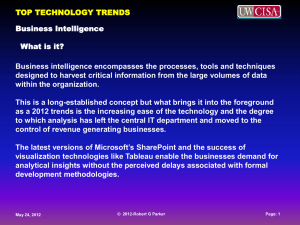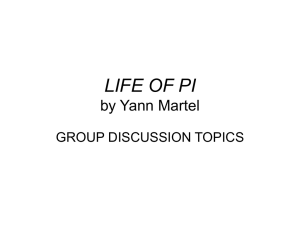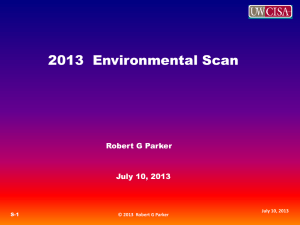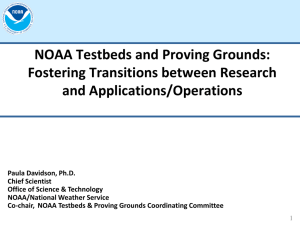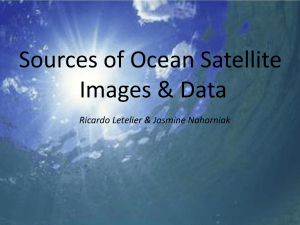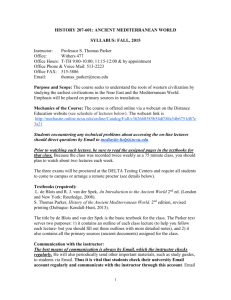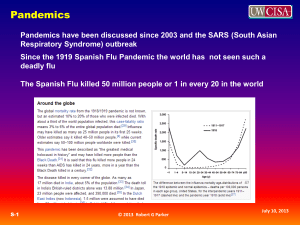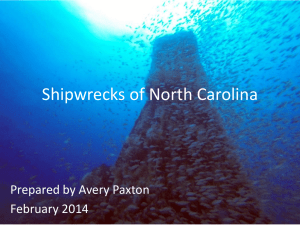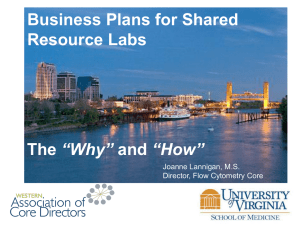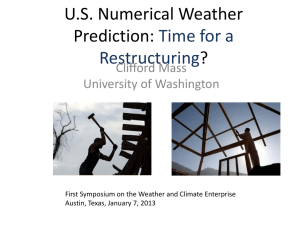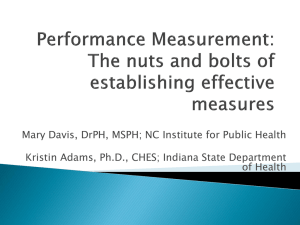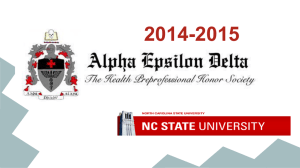PowerPoint file including speaker notes
advertisement
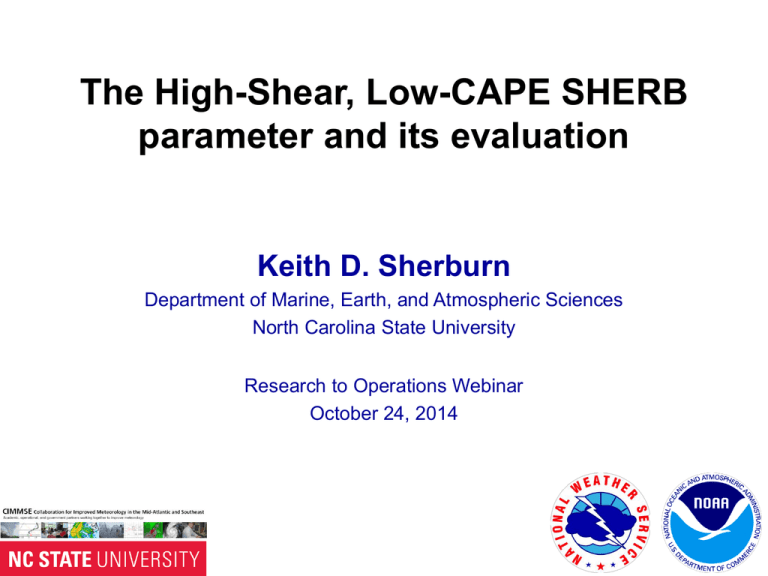
The High-Shear, Low-CAPE SHERB parameter and its evaluation Keith D. Sherburn Department of Marine, Earth, and Atmospheric Sciences North Carolina State University Research to Operations Webinar October 24, 2014 For those attending SLS… • Tuesday posters, 3:00-4:15pm (Sessions 5 & 6): – “Synoptic Influence on High Shear, Low CAPE Convective Events”, Jessica R. King and M. D. Parker – “On the usage of composite parameters in High-Shear, LowCAPE environments”, Keith D. Sherburn and M. D. Parker • Wednesday, 4:45pm (Session 12B): – “High-Shear, Low-CAPE environments: What we know and where to go next”, Keith D. Sherburn and M. D. Parker 2 Background • High-shear, low-CAPE (HSLC) environments: second “key subclass” of severe weather (Schneider et al. 2006) • Over half of significant or violent tornadoes (EF2+) associated with HSLC • Relatively high number of missed events and false alarms • Few operational or modeling studies 3 Typical Features • Cool season/overnight • Strongly-forced • Low LCLs • Low-level instability • Low-level jet • QLCS or minisupercells • Spatially compact • Transient rotation • Little lightning Credit Mike Strickler, WFO Raleigh Sherburn and Parker (2014) ClarkDavis Lane (2009) and Parker Moore (2006) and (2014) Credit Jason Davis Supercell Mesocyclones (9 tor., 13 nontor.) No statistically significant differences QLCS Mesovortices (17 tor., 12 nontor.) Differences mostly vanish aloft Statistically significant differences Only vortices within 60 km of the radar Davis and Parker (2014) Statistically significant differences Davis and Parker (2014) Supercell Reflectivity Signatures Davis and Parker (2014) QLCS Reflectivity Signatures Davis and Parker (2014) Credit Jason Davis SHERB Parameter 11 Maximum TSS of Composite Parameters by Geographic Region Maximum True Skill Statistic 0.6 0.5 0.4 Craven-Brooks EHI SHERBS3 SHERBE STP SCP VGP 0.3 0.2 0.1 0 NR NP UM EGL SP LMV SA Region 12 SHERB Distributions 13 SHERBS3 Availability for Forecasters • AWIPS-1 Volume Browser addition code & instructions https://collaborate.nws.noaa.gov/trac/nwsscp/wiki/AppsAwips/Sherb (AWIPS-2 code under development) • AWIPS-1 and AWIPS-2 GFE tool coding & instructions https://collaborate.nws.noaa.gov/trac/nwsscp/wiki/Gfe/Smarttools/Sherb • Real-time SHERB plots from NC State Real-time RAP – http://storms.meas.ncsu.edu/users/mdparker/rap Real-time NAM – http://storms.meas.ncsu.edu/users/mdparker/nam Real-time GFS – http://storms.meas.ncsu.edu/users/mdparker/gfs • SPC SHERB mesoscale analysis plots Nationwide SHERBS3 – http://www.spc.noaa.gov/exper/mesoanalysis/s19/sherb3/sherb3.gif Nationwide SHERBE – http://www.spc.noaa.gov/exper/mesoanalysis/s19/sherbe/sherbe.gif • SHERB is expected to be added to Bufkit in an upcoming release How not to use the SHERB • To forecast convection • Must be used with a confident forecast of convection • All data points used to develop the SHERB were associated with either severe or non-severe convection • Therefore, cannot be used to forecast convection! • Where convection is not expected • Values potentially above guidance threshold where convection will not occur • In isolation • Composite parameters (e.g., STP, VGP) still exhibit skill, though potentially at lower values than in high-CAPE environments Credit Jonathan Blaes SHERB Feedback • HSLC “One Stop Shop” • http://www.meas.ncsu.edu/mdparker/sherb/index.html SHERB Optimization • Continuing to test different formulations of the SHERB • Statistical and observational tests • New combinations of parameters • Operational tests HSLC CSTAR Articles • Davis and Parker (2014), “Radar Climatology of Tornadic and Non-Tornadic Vortices in High-Shear, Low-CAPE Environments in the Mid-Atlantic and Southeastern U.S.” • Sherburn and Parker (2014), “Climatology and Ingredients of Significant Severe Convection in High Shear, Low CAPE Environments” • Both in Weather and Forecasting (August 2014) Acknowledgements • CSTAR Program • NOAA Grant NA10NWS4680007 • AMS/NOAA NWS Graduate Fellowship • AMS/NASA Earth Science Graduate Fellowship Program • NSF Grant AGS-1156123 • WFO Collaborators • Storm Prediction Center 19 References • Clark, M. R., 2009: The southern England tornadoes of 30 December 2006. Atmos. Res., 93, 50-65. • Dean, A. R., and R. S. Schneider, 2008: Forecast challenges at the NWS Storm Prediction Center relating to the frequency of favorable severe storm environments. Preprints, 24th Conf. on Severe Local Storms, Savannah, GA, Amer. Meteor. Soc., 9A.2. • Dean, A. R., and R. S. Schneider, 2012: An examination of tornado environments, events, and impacts from 2003-2012. Preprints, 26th Conf. on Severe Local Storms, Nashville, TN, Amer. Meteor. Soc., P60. • Lane, J. D., and P. D. Moore, 2006: Observations of a non-supercell tornadic thunderstorm from terminal Doppler weather radar. 23rd Conf. on Severe Local Storms, St. Louis, MO, Amer. Meteor. Soc., P4.5. • Schneider, R. S., A. R. Dean, S. J. Weiss, and P. D. Bothwell, 2006: Analysis of estimated environments for 2004 and 2005 severe convective storm reports. Preprints, 23rd Conf. on Severe Local Storms, St. Louis, MO, Amer. Meteor. Soc., 3.5. 20 Contact Information • Webinar Presenter – Keith Sherburn (kdsherbu@ncsu.edu) • Principal Investigator – Dr. Matthew Parker (mdparker@ncsu.edu) • NWS contributors – Jason Davis (BMX) jason.davis@noaa.gov – Justin Lane (GSP) Justin.Lane@noaa.gov – Jonathan Blaes (SOO RAH) jonathan.blaes@noaa.gov
